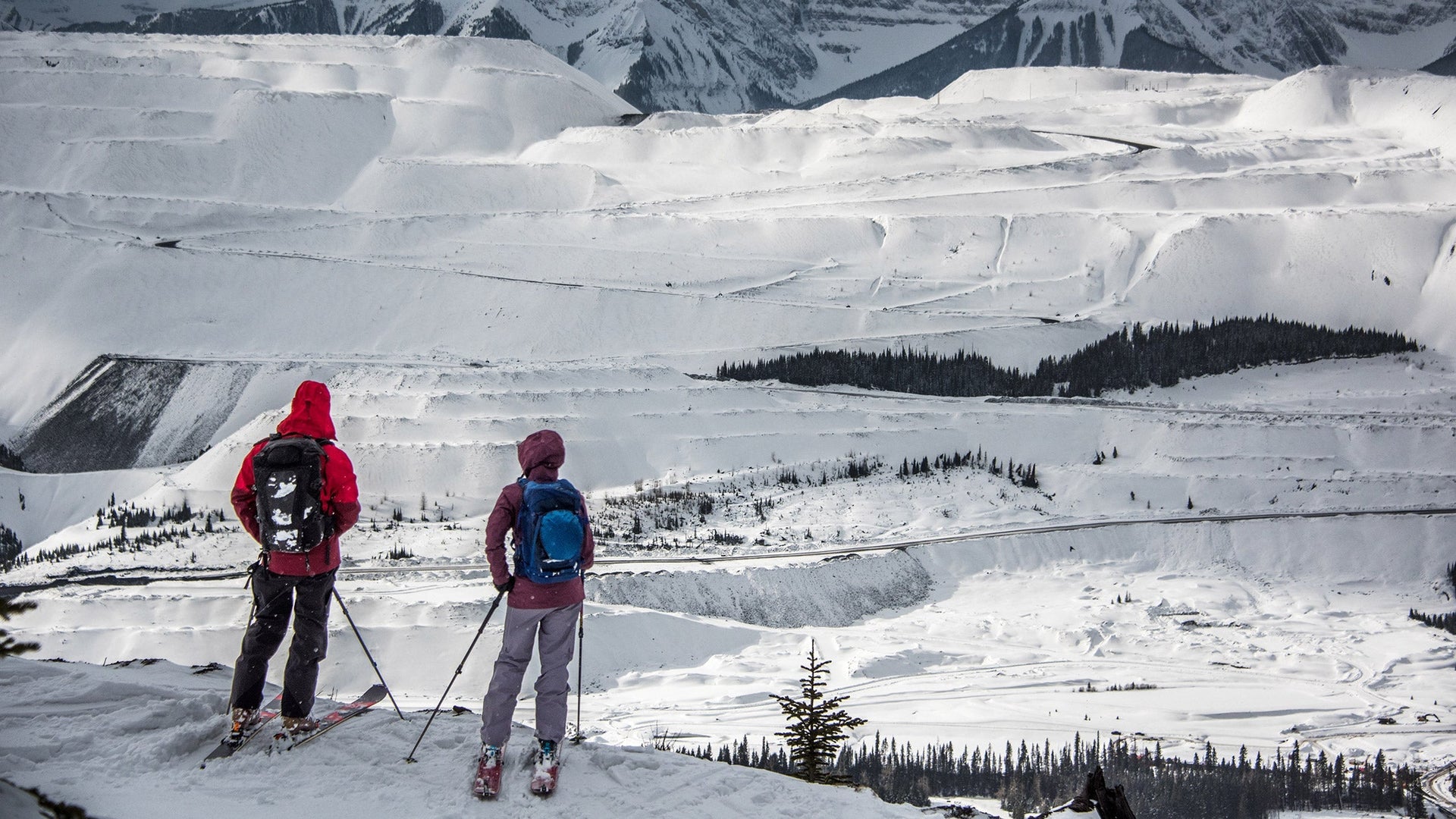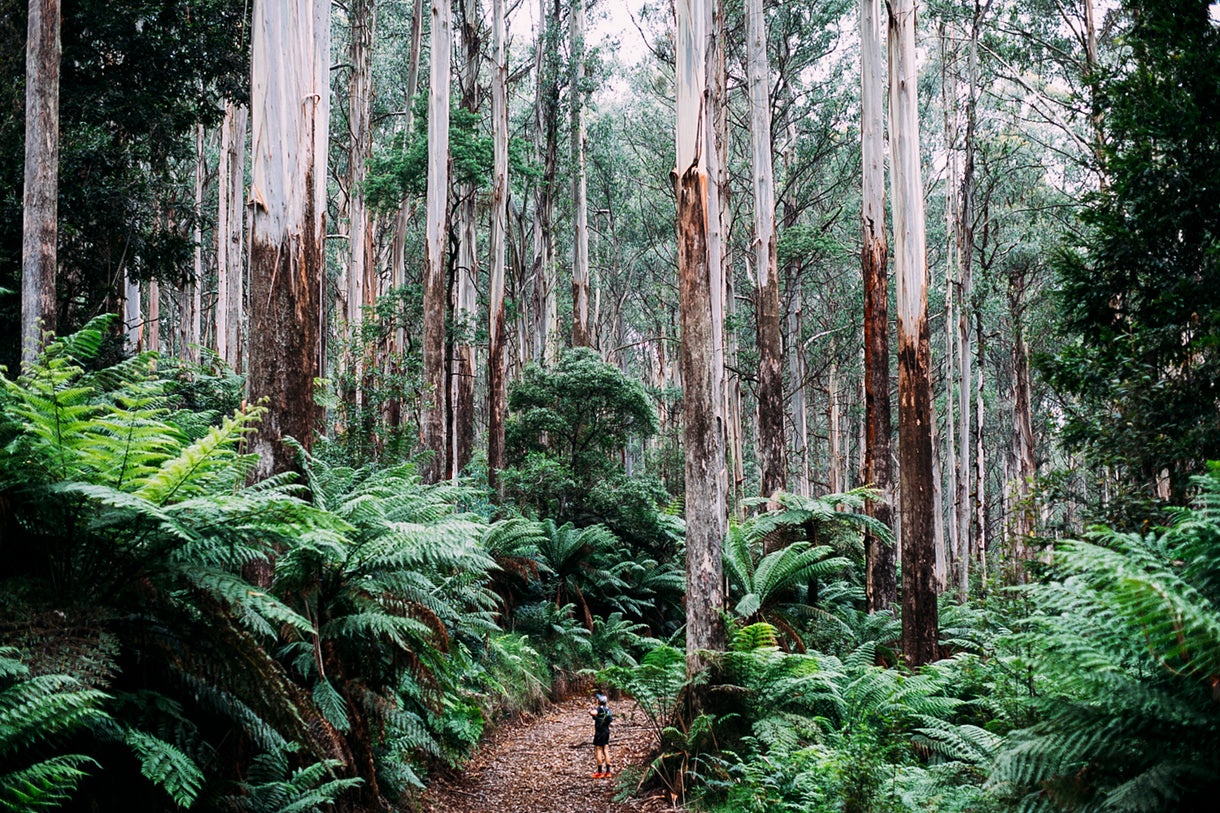Coal built this ski town. Can the locals keep skiing without it?
We are dumbstruck. Skinning through fresh bighorn sheep beds on a ridge overlooking the mines, skier Leah Evans, photographer Kari Medig and I have no words. If we did, clean would not be one of them. As far as we can see, the valley between Greenhills Peak and the base of Mount Pierce on the Continental Divide, just east of where we’re standing on our skis, is a 9-kilometre-wide, man-made hellscape.
Our grief is momentarily dulled by the number of snowy bighorn and elk tracks we see crisscrossing the dump piles below. White dots and lines on a coal canvas. A small herd of elk are even bedded down near the mine boundary, seemingly oblivious to the heavy metal concert of trains, conveyor belts and several dozen huge diesel motors echoing off the pit walls.
From its first icy trickle among fossilised corals and limestone arches at the Pétain Glacier, the Elk River carves a winding path through Qukin ʔamakʔis (“Raven’s Land”), traditional territory of the Ktunaxa Nation, who have lived here for millennia. For almost 50 headwater miles through southeastern British Columbia, it winds through the wilderness of two provincial parks, past a few power line scars and BC forest industry clear-cuts. As the river approaches the town of Elkford and the confluence with the Fording River, everything changes.
Diesel and dust dominate the senses under the shadow of Teck Resources’ Greenhills mine in the river valley. Raven-colored wounds carve the back of the once-mountain. Giant conveyor belts, towers, trucks and trains obtrude upon the landscape.
Less obvious are the hazards in the air and water.
 What’s a river without its fish? The Elk River flowing through Qukin ʔamakʔis (“Raven’s Land”), traditional territory of the Ktunaxa Nation, as it approaches Elkford, British Columbia. Celebrated for its world-class fly fishing, the Elk River is also now known for unhealthy levels of selenium directly linked to nearby mining operations, which have brought fish populations to the brink of collapse. Photo: Kari Medig.
What’s a river without its fish? The Elk River flowing through Qukin ʔamakʔis (“Raven’s Land”), traditional territory of the Ktunaxa Nation, as it approaches Elkford, British Columbia. Celebrated for its world-class fly fishing, the Elk River is also now known for unhealthy levels of selenium directly linked to nearby mining operations, which have brought fish populations to the brink of collapse. Photo: Kari Medig.
The locals talk of black rain, dirty vehicles and houses, and having to wipe down lawn furniture on a daily basis. During the winter, this dust is found accumulated in the snowpack, creating zebra-stripe layers, and then joins the annual runoff every spring, when melting carries it into creeks, lakes and the groundwater below.
Devastating fish die-offs in the Fording River, a tributary of the Elk that drains past Greenhills and neighboring Fording River and Line Creek mines, are attributed to selenium, which regularly exceeds levels considered safe for fish and humans in the river and groundwater.
 Terra firma incognita. Coal dust rises from a midday blast at Teck’s Fording River mine, where the overburden (mining slang for “mountain”) is being manipulated to access buried coal seams hundreds of feet below the surface. Photo: Kari Medig.
Terra firma incognita. Coal dust rises from a midday blast at Teck’s Fording River mine, where the overburden (mining slang for “mountain”) is being manipulated to access buried coal seams hundreds of feet below the surface. Photo: Kari Medig.
Elkford is the self-proclaimed “Wilderness Capital of British Columbia.” The community was founded in 1971 to house miners who worked in the nearby Fording River coal mine, which currently employs over 1,400 people. Together, the Fording River and Greenhills operations—no longer separated by any greenspace—are among the largest open-pit mine sites in the world, and both are majority-owned by the global mining company Teck Resources, based in Vancouver, BC. Everyone in town has some direct connection to the mines. Together Greenhills and Fording River have an annual coal production capacity of over 16.5 million tons, and the two operations have joined and spread cancer-like over ridges and across valleys into one giant destruction pit. What’s wrenched from this stretch of the Rockies might be in the steel of your bicycle or vehicle frame, or the building you work in. Because it is not burned for energy, the industry labels it “clean” coal.
As practiced here, coal mining involves removing the overburden (mining slang for “mountain”) to access buried coal seams hundreds of feet below the surface. Overburden here often hosts rare and endangered habitat. Teck’s mines destroy it all and pose an increasing threat to the people of Elkford and other regional towns.
The jobs that keep people here are destroying what makes it a desirable place to live. But a divorce from coal isn’t straightforward. Elkford, and its ski hill, exist because of the mines. And many locals want to keep their jobs just as they are. So the people of Elkford face the questions we all must, but in somewhat more stark terms. If we have to decarbonise the economy to have much of a future on this planet, how do you do that when a carbon-heavy coal business employs your whole dang town? How do you kick the carbon habit when it’s your economic lifeblood?
 Coal dust crust in the local snowpack, and layers of normal depth hoar, documents the winter storms and winds on a ridge near Teck’s Fording River mine. While the water-quality impacts from this much coal dust across the landscape has not been studied extensively, whatever is in the snow inevitably ends up in the local waterways. Also, it is known that black snow melts much faster than white snow due to a drastically altered surface reflectivity, so could the coal dust impact the health of the snowpack, too? Photo: Kari Medig.
Coal dust crust in the local snowpack, and layers of normal depth hoar, documents the winter storms and winds on a ridge near Teck’s Fording River mine. While the water-quality impacts from this much coal dust across the landscape has not been studied extensively, whatever is in the snow inevitably ends up in the local waterways. Also, it is known that black snow melts much faster than white snow due to a drastically altered surface reflectivity, so could the coal dust impact the health of the snowpack, too? Photo: Kari Medig.
“You can see my office right over there,” says 24-year-old mining engineer Abbey Peterson, as she points from the upper patrol shack of Wapiti Ski Club to the Greenhills mine. Peterson is head of ski patrol and runs the ski school at Wapiti, the miner-built and volunteer-run hill, which grew from the seed of an $18,000 donation from Fording Coal Ltd. in the early ’70s.
“Right now I am on the blast crew, which is awesome,” says Peterson, whose blue-lipsticked grin and Faction monoski seem at odds with the armada of jacked-up pickups and baseball hats in the parking lot below. “I love Elkford. Housing is cheap, the mountains are awesome, and I can hop on my dirt bike in my driveway and ride the 50 miles to Elk Lakes Park all on trails.”
“You do see some people pressure-washing their houses every spring, and you have to dust a lot,” Peterson says, when asked about the coal dust in the air, “but really, it is a small price to pay for an awesome job in an awesome place.”
Nearly 50 years ago, locals started clearing runs to get a small rope tow running for the winter of 1973–74. Volunteers added a T-bar lift and more ski runs with sweaty summer work parties. The lodge went up in 1983, and the club purchased a used snowcat for grooming. Since it came with no engine, coal miner Rod Hooper had to help bring it back to life.
Hooper and his young family arrived in Elkford from England in 1975, taking a job as a heavy-duty mechanic at the Fording River mine, where he worked until his retirement in 2006. Hooper threw his spare time and energy into the growing Wapiti Ski Club, even taking a turn as club president.
“Everybody pitched in to make it work. I used to groom, run the lift and manage the hill when it was my turn,” he says.
Hooper’s knees have curtailed his skiing, but he is still up at the hill most weekends, back to sipping coffee in the lodge while his grandchildren fall in love with gravity on the mountain.
He looks out with a grin at the vibrating T-bar line that boasts over 40 kids, “This is what Elkford, and Wapiti, is all about.”
 Train cars to be filled with coal at Fording River Operations near Elkford, British Columbia. A significant amount of the coal from Elk Valley travels over 600 miles by rail to Vancouver and then is shipped across the world, primarily to China, where it’s turned into steel. Photo: Kari Medig.
Train cars to be filled with coal at Fording River Operations near Elkford, British Columbia. A significant amount of the coal from Elk Valley travels over 600 miles by rail to Vancouver and then is shipped across the world, primarily to China, where it’s turned into steel. Photo: Kari Medig.
Most locals don’t want to change anything about home. And the ones who might will air their concerns in private or on forums behind the ease of an alias. Or they don’t work for the mines.
In her nearly 40 years living and working in the Elk Valley, 59-year-old Lee-Anne Walker has been a fighter for better water quality. Founder and senior adviser to the grassroots Elk River Watershed Alliance, she has been trying to repair what she calls a “toxic relationship between industry and environmentalists” to protect the water in the river that so many rely on and love so dearly.
In 2010, Walker founded the Elk River Watershed Alliance to help community, industry and government work together, and she has spent the past decade building trust and respect between players.
“Industry, for the most part, wants to do a better job,” she says. “A lot of people I meet in Teck want to both make money and do better environmentally, and are working hard at both. Are they successful yet? No. And maybe they will never be.”
 Elkford resident, head of ski patrol and ski school director at Wapiti, Abbey Peterson. Photo: Kari Medig.
Elkford resident, head of ski patrol and ski school director at Wapiti, Abbey Peterson. Photo: Kari Medig.
Despite the fact that toxins regularly exceed allowable levels at some observation stations, there never seems to be a hard deadline set to correct the problems. Teck’s own reporting details exceedances of water-quality guidelines just downstream of their mines, and even notes that levels of cobalt, nitrite and uranium linked to mining activities surpass permit guidelines. But BC is run by industry—and advocates for mining law reform argue that there are very few enforceable laws and little will to enforce “legal limits” when they are exceeded.
Groundwater is another concern in the Swiss cheese–limestone foundations of the Canadian Rockies. Teck provides local residences with bottled drinking water when their wells fail to meet BC’s provincial standards. And the company recently spent $5 million of their “clean” coal profits on a new well for the community of Sparwood after one of their municipal wells seasonally tested over British Columbia’s allowable limits for selenium.
 Rod Hooper’s son, Phil Hooper, carries on his father’s commitment to the ski hill as the current president of the Wapiti Ski Club. Photo: Kari Medig.
Rod Hooper’s son, Phil Hooper, carries on his father’s commitment to the ski hill as the current president of the Wapiti Ski Club. Photo: Kari Medig.
Meanwhile, the fish in the Fording River are disappearing. Signs of selenium poisoning in fish show up at 0.002 parts per million, but in a 2014 report, Environment and Climate Change Canada (ECCC) announced levels between 0.03 and 0.113 ppm. Westslope cutthroat trout eggs had selenium levels almost 10 times above the fish toxic threshold, and abnormally high rates of adult fish body deformities, including abnormal gills, are linked to this toxicity. An independent expert reviewing ECCC’s work concluded that trout deaths from selenium poisoning in the Upper Fording River must be reduced to zero or the population faced total collapse.
Nobody was surprised in 2019 when Teck revealed that 90 percent of the fish in the Fording River were gone.
 Lee-Anne Walker, executive director of the Elk River Watershed Alliance, tests for turbidity on Lizard Creek near Fernie, BC. Lizard Creek is used as a control site because it is one of a few mostly undeveloped tributaries of the Elk River. Photo: Kari Medig.
Lee-Anne Walker, executive director of the Elk River Watershed Alliance, tests for turbidity on Lizard Creek near Fernie, BC. Lizard Creek is used as a control site because it is one of a few mostly undeveloped tributaries of the Elk River. Photo: Kari Medig.
Air quality, of course, follows a similar arc. Teck points to data from seven air-quality monitoring sites—most of which are upwind of the pits and close to or in residential areas—to assure residents that their air is safe to breathe. A 2019 report details 226 “exceedances” of BC provincial air-quality objectives, which Teck blames on forest fires in the summer or possibly local woodstoves that create winter dust.
To mediate any concerns, Teck has an extensive dust management program—which includes a fleet of water trucks for the mine roads, misters for dump piles, and seal coating on stockpiles and railcar loads—and there are reports of them hiring professional cleaners to deal with excessive dust at people’s homes. But, even on Teck-hosted air-quality forums, folks continue to raise questions about the long-term health effects of exposure to dust levels so high that a washed car is visibly dusty the following day.
 Volunteer ski patroller Brayden Sorensen at the top of the Wapiti Ski Club T-bar. Photo: Kari Medig.
Volunteer ski patroller Brayden Sorensen at the top of the Wapiti Ski Club T-bar. Photo: Kari Medig.
Despite poison in the rivers and toxins in the air, there are three new proposed open-pit coal mines in various stages of the approval process in the Elk Valley, plus Teck’s proposed Castle expansion for the Fording River/Greenhills mine. In fall 2020, frustrated with BC’s inability to curtail the increasing environmental impacts, pressure from First Nations, conservation groups and even the US Environmental Protection Agency successfully pushed for a federal environmental assessment of the Castle expansion.
 An elderly couple walks back to the parking lot after visiting Wapiti Ski Club. Photo: Kari Medig.
An elderly couple walks back to the parking lot after visiting Wapiti Ski Club. Photo: Kari Medig.
Even if the federal assessment prevents the Castle expansion, Elkford is slowly being poisoned. But if left unchecked, the current water and air crises in the Elk Valley will continue to pit the skier-miners against the land they’ve come to call home.
Numbed on an unnamed ridge with an uncertain future, we ski what may be a first and last descent. It’s ground zero of Teck’s proposed Castle expansion, with preconstruction blasting possibly beginning as early as 2023. If it is approved for this pile of overburden, a massif covered in south-facing grassy slopes broken by bands of sheltered timber (including endangered white bark pine), and pocked with fresh bighorn sheep beds and tracks, will be reduced to another shattered hole.
 An elk crosses under a coal conveyor belt that stretches over Fording River Road. Photo: Kari Medig.
An elk crosses under a coal conveyor belt that stretches over Fording River Road. Photo: Kari Medig.
Banner image – A coal mining operation might look cleaner covered in snow, until you discover the coal dust buried throughout the snowpack, dirtying nearby cars and houses, poisoning local fish populations and polluting the air. Yet, here at Teck Resources’ Greenhills and Fording River mines the coal extracted is labeled “clean” because it isn’t burned for energy. Leah Evans and Dave Quinn overlook a small section of the 6-mile-wide coalscape. Elkford, British Columbia. Photo: Kari Medig.
____________________________________________________________________

























































